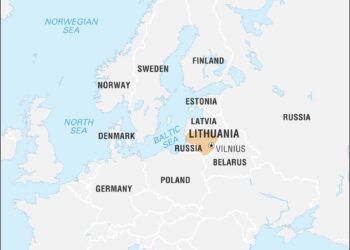Lithuania has closed its airports and border crossings with Belarus following multiple reports of unidentified balloon sightings, authorities announced on Thursday. The unprecedented security measures come amid heightened regional tensions and fears over potential surveillance activities. Lithuanian officials have urged the public to remain vigilant as investigations into the origin and purpose of the balloons continue. This move marks a significant escalation in the Baltic state’s efforts to safeguard its airspace and borders in an increasingly volatile geopolitical environment.
Lithuania Closes Airports and Border Crossings Amid Unidentified Balloon Sightings
In an unprecedented move, Lithuanian authorities have temporarily closed all airports and border crossings with Belarus after multiple sightings of unidentified balloons in its airspace. The closures, aimed at ensuring national security and public safety, have led to widespread disruptions in transportation and logistics. Officials have indicated that the balloons exhibit unusual flight patterns, sparking concerns over potential surveillance or espionage activities.
Key measures taken include:
- Suspension of commercial and private flights at all international airports
- Closure of all road and rail border crossings with Belarus
- Deployment of additional air defense and border patrol units
- Intensified airspace monitoring with radar and ground-based sensors
| Location | Status | Impact |
|---|---|---|
| Vilnius Airport | Closed | All flights suspended until further notice |
| Kaunas Airport | Closed | Passenger and cargo operations halted |
| Belarusian Border Crossings | Sealed | Land traffic blocked; increased surveillance |
Security Implications of Balloon Incursions on Baltic Airspace and Borders
The recent balloon sightings over Lithuanian airspace have escalated concerns about the vulnerability of Baltic borders to unconventional aerial intrusions. Authorities responded swiftly by closing airports and border crossings with Belarus, signaling a heightened state of alert amid fears of potential espionage or sabotage activities. Such incursions challenge traditional defense mechanisms, exposing gaps in regional surveillance systems that rely heavily on radar capable primarily of detecting fast-moving aircraft rather than slow, high-altitude balloons. This development has prompted security analysts to question whether current airspace monitoring technologies are adequately equipped to counter emerging aerial threats from non-traditional platforms.
In response, Lithuania and neighboring Baltic states are accelerating efforts to integrate advanced detection capabilities and enhance cross-border intelligence sharing. The incident underscores the geopolitical tension in the region, emphasizing the strategic importance of robust airspace governance. Key security implications include:
- Disruption of civilian air traffic affecting economic and logistical networks
- Increased military readiness along sensitive border areas
- Potential escalation of diplomatic strains between Lithuania and Belarus
- Necessity for collaborative Baltic and NATO response frameworks
| Aspect | Impact | Response |
|---|---|---|
| Air Traffic | Airport closures, flight delays | Temporary suspension of routes |
| Border Security | Restricted crossings, increased patrols | Heightened surveillance and checks |
| Military | Elevated tension, readiness alerts | Deployment of rapid response units |
Recommended Measures for Enhancing Surveillance and Cross-Border Coordination
In light of recent balloon sightings prompting heightened security measures, it is imperative for Lithuania and neighboring countries to bolster their surveillance frameworks. This includes the integration of advanced aerial monitoring systems, equipped with real-time data analytics, to swiftly detect and classify unidentified objects crossing into sovereign airspace. Enhanced cooperation among national security agencies is crucial to ensure a rapid, coordinated response to potential aerial threats.
Cross-border coordination can be further improved by implementing:
- Joint intelligence-sharing platforms to maintain up-to-date situational awareness
- Regular multinational drills simulating aerial incursions to streamline response protocols
- Shared air traffic control communications to minimize reaction time during emergencies
| Measure | Benefit | Expected Outcome |
|---|---|---|
| Advanced Aerial Surveillance | Early Detection | Reduced Response Time |
| Multinational Intelligence Sharing | Unified Threat Assessment | Strengthened Regional Security |
| Joint Emergency Drills | Enhanced Coordination | Seamless Incident Management |
Insights and Conclusions
As Lithuania takes decisive steps to tighten its airspace and border security in response to the recent balloon sightings, the situation underscores growing regional tensions and the challenges of safeguarding national sovereignty. Authorities continue to monitor developments closely, with further updates expected as investigations progress. The incident highlights the delicate balance between security concerns and diplomatic relations in Eastern Europe.














